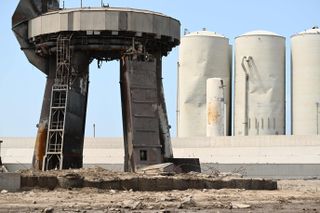SpaceX’s starship has been grounded by the US government following claims that the rocket’s explosive first launch sent potentially hazardous debris plumes over homes and endangered animal habitats.
The Federal Aviation Administration (FAA) – the US civil aviation regulator – has barred SpaceX from conducting any further launches until an “accident investigation” into Starship’s April 20 test launch is completed. The giant rocket’s dramatic flight began with a crater in the concrete below the launchpad and ended about 4 minutes later when the giant rocket exploded in mid-air.
Dust and debris from the test reportedly rained down on residents in Port Isabel, Texas — a town about 6 miles (10 kilometers) from the launchpad — and on the beaches of Boca Chica, which provide nesting grounds for endangered animals including birds and sea turtles.
Related: Geomagnetic storm sends 40 SpaceX satellites to Earth
Dave Cortez (opens in new tab)The chapter director of the Sierra Club environmental advocacy group said Port Isabel residents reported broken windows in their businesses and ash-like particles covering their homes and schools.
SpaceX’s launchpad also sustained extensive damage, including charred, twisted metal and shattered concrete. The force of the rocket’s engine blew a hole in the launchpad and created a crater beneath it. “Concrete spilled out into the sea,” Cortez told CNBC (opens in new tab)Creating shrapnel that “risks hitting fuel storage tanks that are silos adjacent to this launch pad.”
Unlike other launch sites for large rockets, SpaceX’s Boca Chica site lacks both a deluge system, which floods the pads with shockwave-suppressing water or foam, and a flame trench to safely remove burning exhaust.
Elon Musk, founder of SpaceX, “aspired to have no flame diverter in Boca, but this may be a mistake.” wrote in an October 2020 tweet.
The FAA’s accident investigation is a standard practice when a rocket goes astray. An FAA investigation will need to conclude that Starship does not affect public safety before it can resume operations. As the debris spread farther than expected, the FAA’s “Anomaly Response Plan” also came into play, meaning SpaceX must complete additional “environmental mitigation” before reapplying for its launch license.
Musk wrote on Twitter that SpaceX began work on “a large water-cooled, steel plate to go under the launch mount” three months before the launch, but it was not ready in time.
“It looks like we may be ready to relaunch in 1 to 2 months,” he added.
Standing 394 feet (120 meters) tall and powered by a record-breaking 16.5 million pounds (7.5 million kilograms) of thrust, SpaceX’s Starship is the largest and most powerful rocket ever built. Capable of carrying 10 times the payload of SpaceX’s current Falcon 9 rocket, Starship was designed to transport crew members, spacecraft, satellites and cargo to locations in the solar system.
After blasting off from its launchpad at Boca Chica, the Starship climbed to a maximum altitude of 24 miles (39 km) before eight of the rocket’s 33 Raptor 2 engines developed problems, causing the Starship to flip over and leading SpaceX to order the rocket. was made to self-destruct.
Despite the rocket’s unexpectedly erratic takeoff and fiery death, SpaceX and Musk hailed the test as a success that enabled engineers to collect essential data for the next launch. On April 16, four days before the test, Musk lowered expectations in a Twitter discussion (opens in new tab) That if any of the rocket’s engines go wrong “it’s like a box of grenades, really big grenades.”
“This is really kind of the first step in a very long journey that requires a lot of flights,” Musk said. “For those who have actually followed the history of Falcon 9, and Falcon 1, and our attempts at reusability, I think we may have had about 20 attempts before we actually recovered a stage. Reusability that made sense, where we didn’t have to rebuild the entire rocket. .”
#Disastrous #SpaceX #launch #federal #investigation #potentially #hazardous #debris #rained #homes #beaches




